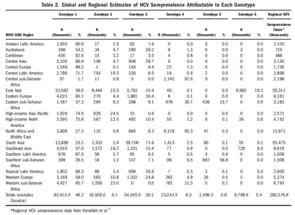 |
| Chart of global and regional estimates of HCV seroprevalance by genotype. (Click to see a larger version) |
For the first time, researchers have mapped out the global incidence estimates for the hepatitis C virus (HCV), breaking down the number of current infections both by their location and via the six different viral strains of the disease, according to a new report published in the journal Hepatology on World Hepatitis Day, which took place Monday, July 28.
The study authors say it could help address treatment discrepancies among people living with less-common genotypes of hepatitis C. The study could also aid health workers in determining the most cost-effective strategies to combat the virus and help other scientists identify potential barriers to the development and distribution of an HCV vaccine that works against all strains.
For the study, researchers at Oxford University in the United Kingdom combined more than 1,200 studies from around the world, creating a representation of 90 percent of the global population living with HCV. According to the report, more than 185 million people are affected by the liver disease worldwide. Genotype 1, which responds best to the latest and most effective HCV treatment, was found to be the most common strain of hep C around the world, with all other genotypes together making up a little more than half of the remaining cases.
The prevalence of various hepatitis strains was found to vary dramatically from place to place. In South Asia, genotype 3 was found to be the most common. In other parts of Africa and the Middle East, genotype 4 prevailed.
Researchers say the wide range of viral strains presents a problem because most drug trials focus on people with genotype 1. Meanwhile, drug trials overlook less common HCV strains, such as genotypes 2, 4, 5 and 6, which are most common in developing nations. Doctors theorize that different genotypes may need different lengths and even types of treatment.
For a copy of the full report, titled Global Distribution and Prevalence of Hepatitis C Virus Genotypes, click here.






Comments
Comments